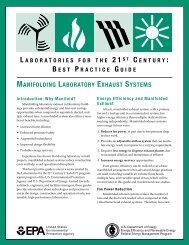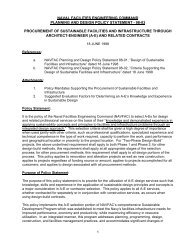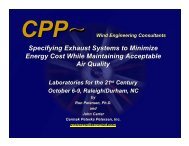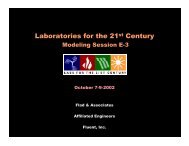Advanced Fume Hoods - Lawrence Berkeley National Laboratory
Advanced Fume Hoods - Lawrence Berkeley National Laboratory
Advanced Fume Hoods - Lawrence Berkeley National Laboratory
- No tags were found...
Create successful ePaper yourself
Turn your PDF publications into a flip-book with our unique Google optimized e-Paper software.
Low Flow Constant VolumeDynamic Barrier TM Hood! First Section based on April 2000 articlein <strong>Laboratory</strong> Design Newsletter by Dr.Robert Haugen and Rudolf Poblete ofKewaunee Scientific, Statesville, NC! Owners want to lower hood operatingcosts.! Option 1: Low Flow Constant Volume! Option 2: Variable Air Volume Controls
<strong>Fume</strong> Hood Baffles
Restricted Hood Opening Test• ASHRAE 110 Testing, At 100 and 40 fpm,results were less than 0.05 ppm.• But Manufacturer Doesn’t recommend below80 fpm.• A shorter manikin height did not affectcontainment.• In actual use, a walk-by at 200 feet per minutecan often overcome a 40 fpm face velocityvector.
ASHRAE 110 Tracer Gas Test
Energy/ Cost Savings• Smaller openings offer more containment andmore protection allowing energy efficiencywith higher face velocities.• 6’ Hood, 22” wide x 10” opening, 80 fpm, 350cfm saves $3,760 per year vs. standard 1290cfm hood. (All calcs. Use $4/cfm)• Internal hood airflow below 5 airchanges/min.can cause corrosion when using heated acids.
FisherHamilton Designs• Information Provided by Jon Zboralski ofFisherHamilton, Two Rivers, Wisconsin• Cost/ Complexity/ Containment Score(3-C’s)• Tradeoffs between additional cost, additionalcomplexity, limits on user accessibility, andsought after increases in containment.• Restricted openings limit user accessibility.• “Barrier” airfoils limit user accessibility.• Reduced volumes affect dilution rates.• Reduced Face Velocities more affected byworker movement, traffic, and airconditioningdiffusers.
FisherHamilton Concept Hood! Sash automatically drops to 18” highvertical opening if not physically held.! Offered 4,5,6,7,8ft with 31.25”, 37.25” and43.25” depths.! Low Flow at 80 fpm, can be run at 60 fpmin setup mode
Concept <strong>Fume</strong> Hood vs.Local Ventilation
FisherHamilton Concept Hood! Downflow Bypass Air! Celing Enclosure for sash has bypass airdrawn from room and not from above clg.! Flush Airfoil Sill washes worktop withoutlimiting user accessibility, hascontainment trough, and cord passthru.
HOPEC IV – XD! Operates Down to 60 feet per minute! 26” and 18” Manikin Challenge Heights! Barrier Airfoil gives ASHRAE 110Containment < 0.05 ppm, 39” Deep.! Barrier Airfoils typically 1 ½” high andextending 6” into hood improvecontainment but limit use of hood.
In Development! Pioneer Hood to be Introduced Soon! ASHRAE 110 Committee studyingrelation of heat loading in hood andsusceptibility to walk-by leakage.
LabCrafters Air Sentry Hood! Material based on LabCraftersInformation Package and interview withRobert DeLuca and Robert H. Morris! Introduced 5 years ago! Over 500 installed! Developed for low velocities,– 40-60 feet per minute
LabCrafters Air Sentry Hood! Utilizes Moving Rear Baffle and Barriertype Air Foil! Deeper Chamber Dimension! Based on Bi-Stable Vortex Technology! Uses VFV TM Vortex Sensor for Alarm
LabCrafters Air Sentry Hood
LabCrafters Air Sentry Hood!Has Upper Chamber Turning Vane!Multi-Slot Airfoil!Aerodynamic Side Posts!See Engineered Systems Magazine,January 2000 issue for generalbackground to fume hood issues
AccuAire Sash Closer!One of the few commerciallyavailable sash closers on themarket.!Uses proximity sensor to open sashwhen user walks up.!Has infrared sensor to stop sash incase of obstruction.
Labconco XStream!Designed to operate at 60 fpm.!Eliminates Vortex with:– Upper Dilution Air Supply washingsash– Rear Downflow Dual Baffle System– Perforated Back Baffle– Clean Sweep TM Aerodynamic Air Foil
Labconco XStream!Perforated Sash Handle directscontaminants back into hood! 6’ Hood at 60 fpm, 945 cfm!Savings of $1880 per yearvs. 100 fpm hood and anopening of 28”, 0.11”w.g.sp
<strong>Berkeley</strong> High PerformanceHood!Patented, with 5 years of researchand development and $500,000budget, by the <strong>Lawrence</strong> <strong>Berkeley</strong><strong>National</strong> <strong>Laboratory</strong>.!Funds provided by the U.S.Department of Energy, University ofCalifornia, CIEE, and SCE
<strong>Berkeley</strong> High PerformanceHood!Designed to operate at 30 fpm!Field tests for over a year atUniversity of California, SanFrancisco and Montana StateUniversity!Additional field tests currently beinginstalled.
Push-Pull Concept!One of more small fans push roomair into the hood eliminating thevortex or roll effect, an air divider!Gentle Air curtain down the sash!Perforated Rear Panel
Design Concepts!Perforated Airfoil!Chamber Design tested in multiplemock-ups and extensive computerfluid dynamic simulations
Computer Airflow Simulation
<strong>Berkeley</strong> Hood!<strong>Lawrence</strong> <strong>Berkeley</strong> <strong>National</strong><strong>Laboratory</strong> is negotiating withvarious manufacturers to licensethis technology.!Successful manufacturer isexpected to go into production in2002.
<strong>Fume</strong> Hood Systems!Need more emphasis on operatortraining. An unsafe fume hood usercan not be saved by a safe hood.!Over 5% of hoods have contaminantreleases monthly due to badexhaust fan design.!Eliminate cross-drafts especiallyfrom air-conditioning vents.
VAV <strong>Hoods</strong>!Need minimum turndown volumesto prevent extreme corrosion orflammability.!VAV hoods, operated properly, willsave more energy than even themost aggressive low flow constantvolume fume hoods.
Questions?Victor A. Neuman, PETek-Air Systems Inc.email: v.neuman@tek-air.com












